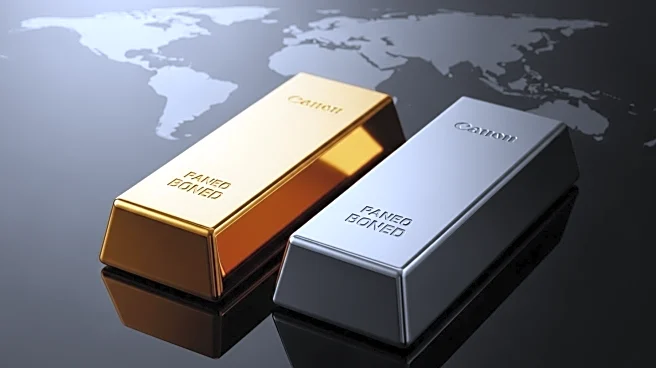What's Happening?
Gold prices have reached unprecedented levels, surpassing $4,000 per ounce, marking a significant milestone in 2025. Randy Smallwood, CEO of Wheaton Precious Metals Corp., has forecasted that gold could climb to $5,000 within a year and potentially double to $10,000 by the end of the decade. This surge is attributed to geopolitical uncertainty, robust central bank buying, and expectations of U.S. rate cuts. The value of gold has increased by about 50% this year, its best performance since 1979. Investors are turning to gold as a hedge against inflation and economic uncertainty, driven by factors such as President Trump's tariff threats, high interest rates, a weaker U.S. dollar, and a slow labor market.
Why It's Important?
The rise in gold prices has significant implications for investors and the broader economy. As a traditional safe haven asset, gold's ability to maintain value during economic instability makes it attractive to investors seeking protection against inflation and currency devaluation. The prediction of further price increases could lead to increased investment in gold, impacting financial markets and influencing central bank policies. The potential for gold to reach $10,000 by the decade's end suggests a shift in investment strategies, with more stakeholders considering gold as a long-term asset. This trend could affect industries reliant on gold, such as jewelry and electronics, due to increased costs.
What's Next?
The Federal Reserve's anticipated interest rate cuts could further influence gold prices, as lower rates typically make non-interest-bearing assets like gold more appealing. Central banks are expected to continue diversifying their reserves with gold, potentially increasing global gold reserves. Investors and financial analysts will closely monitor these developments, assessing the impact on stock markets and other asset classes. The ongoing geopolitical tensions and economic policies will play a crucial role in shaping gold's trajectory, with stakeholders preparing for potential fluctuations in the market.
Beyond the Headlines
The surge in gold prices highlights broader economic concerns, including the stability of the U.S. dollar and the impact of geopolitical risks on global markets. As central banks increase their gold holdings, questions arise about the long-term implications for currency reserves and international trade. The reliance on gold as a hedge against uncertainty underscores the need for diversified investment strategies and the importance of monitoring economic indicators. This trend may also prompt discussions on the ethical and environmental aspects of gold mining, as demand for the precious metal continues to rise.











